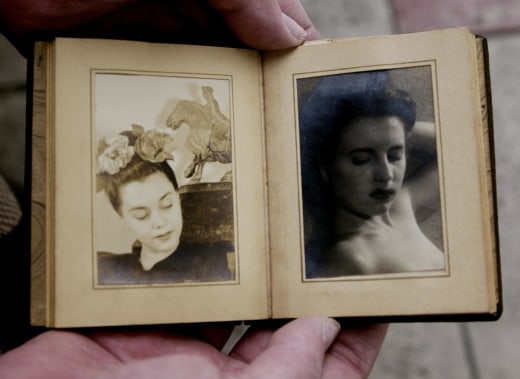Reblogged from http://www.nbcnews.com/news/us-news/ex-cop-cites-new-evidence-his-dad-was-black-dahlia-n119861
Ex-Cop Cites New Evidence His Dad Was Black Dahlia Killer
From NBC Los Angeles
First a cadaver dog, now chemical analysis support the suspicions of a retired police detective that human remains were buried in the foothills above Hollywood decades ago, NBC4 has learned.
Analysis of soil taken from a location indicated by the cadaver dog found chemical markers for human decomposition, said the scientist who performed the labwork at the request of the retired detective.
It's the theory of former detective that as many as 10 long-unsolved slayings of young women in Los Angeles in the 1940's were committed by a single serial killer.
What adds poignance to Hodel's suspicion is his personal connection to the suspect he's identified: the late medical doctor George Hodel -- the retired detective's father.
"I see him as Dr. Jekyll and Mr. Hyde," said Hodel, alluding to the fictional split personality depicted in one of Hollywood's first horror films. "Unfortunately, the monster, Mr. Hyde, was stronger and over-ruled the good."
Hodel's suspicions date back more than a decade. After his father's death, going through possessions, Hodel came across evidence that implicated his father in the infamous 1947 dismemberment murder of a young woman named Elizabeth Short, remembered to this day as the Black Dahlia.
Writing books and continuing his research, Hodel came to suspect his father had killed repeatedly before fleeing to Asia in the late 1940s.
During that decade, the Hodels lived in what is now regarded as a Hollywood landmark, the Sowden House designed by the famed architect Lloyd Wright in the distinctive Mayan block style that was developed by his even more famous father Frank Lloyd Wright.
Records long stored in the District Attorney's office confirm that the doctor had come under suspicion in the Dahlia case, and that police had planted a listening bug in the house. Transcripts reveal that detectives heard him discussing the Dahlia at one point. At another time, they heard from the basement what sounded like a woman being attacked.
Hodel believes his father committed murders in or near the house, and in some cases buried the remains nearby in unmarked graves.
In 2012, Hodel was able to return to the Sowden house when he was invited to participate in a TV program being recorded there. Hodel got permission to bring along another retired cop, former Mammoth Lakes Police Sgt. Paul Dostie, who has worked extensively with Buster, his search dog.
Buster indicated a scent of human decomposition at several locations, including in the alley behind the house. But where the scent is picked up does not necessarily mean that is where the chemical remains are located; carried over time by water or gravity, the marker molecules can migrate considerable distances, according to forensic anthropologist Arpad Vass, PhD, a pioneer in chemical analysis of human decomposition.
 RIC FRANCIS / AP file
RIC FRANCIS / AP file
A soil sample was taken from the alley, and late last year Vass used gas chromatography and mass spectrometry to identify the chemicals in it.
"The soil came up positive for human remains because there are a number of human specific markers," said Vass from his laboratory in Oak Ridge, Tennessee.
What is more difficult is narrowing down how long ago death occurred. Vass's estimate: 20-100 years ago.
The chemical analysis cannot help determined cause of death, or even whether or not it was homicide, Vass noted. But he said his findings are "consistent" with Steve Hodel's theory of homicide victims buried in shallow graves 70-80 years ago.
"We're talking about clearing potentially 10 cases," Hodel said.
But who?
Definitely not Elizabeth Short, Hodel is quick to say, pointing out that all of her remains were accounted for.
But the possibilities include actress Jean Spangler, then 26, her career on the rise in 1949 when she vanished. Nothing more than her purse was found days later in Griffith Park, not far from the Hodel home. A note inside hinted she was going to have an abortion, then illegal. Dr. Hodel was one of the few physicians who then performed abortions in Los Angeles, Steve Hodel found in his research. He also discovered Spangler and his father had a mutual friend.
Hodel hopes to search further for the human remains, but has been unable to get permission to go onto the privately owned hillside.
After repeated attempts by Hodel the past decade to interest LAPD in following up on his civilian investigation, LAPD passed again.
"Too old, too cold." was the feedback Hodel said he got.
But if it appears the ageless sleuth is running out of leads to pursue--don't count on it.
His research has led to three books, Black Dahlia Avenger, Black Dahlia Avenger II, and Most Evil, in which Steve Hodel lays out his case that when his father traveled to northern California in the 1960s he committed the infamous Zodiac murders.
Steve Hodel still hopes to find the source of the scent of human decomposition near his childhood Hollywood home.
"I'm going to keep digging," Hodel vowed--figuratively, if not literally.
A

No comments:
Post a Comment